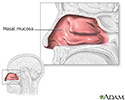Nonallergic rhinopathy
Rhinitis - nonallergic; Idiopathic rhinitis; Nonallergic rhinitis; Vasomotor rhinitis; Irritant rhinitisRhinitis is a condition that includes a runny nose, sneezing, and nasal stuffiness. When environmental allergies (such as hayfever) or a cold are not causing these symptoms, the condition is called nonallergic rhinitis. One type of nonallergic rhinitis is called nonallergic rhinopathy. This condition used to be known as vasomotor rhinitis.
Causes
Nonallergic rhinopathy is not caused by an infection or allergy. The exact cause is unknown. Symptoms are triggered by something that irritates the nose, such as:
- A dry atmosphere
- Air pollution
- Alcohol
- Certain medicines
- Spicy foods, and in some cases, while eating in general
- Strong emotions
- Strong odors, such as perfumes, cleaning products (especially bleach) among others
Symptoms
Symptoms include:
- Runny nose
- Nasal congestion (stuffy nose)
- Sneezing
- Watery nasal drainage
Exams and Tests
Your health care provider will ask about your symptoms, when they occur, and what seems to trigger them.
You will also be asked about your home and work environment. Your provider may look inside your nose to check if the tissues lining your nose are swollen due to inflamed blood vessels.
A skin test may be done to check for specific allergies as a cause of your symptoms.
Skin test
Allergy skin tests are used to find out which substances cause a person to have an allergic reaction. These substances are called allergens....

If your provider determines you can't have skin testing, special blood tests may help with the diagnosis. These tests, known as IgE allergen tests, can measure the levels of allergy-related substances. They also measure total IgE levels, which correlate to allergy or lack of allergy. A complete blood count (CBC) test can measure eosinophils (allergy-type white blood cells) to get a total eosinophil count. This may also help diagnose allergies.
Eosinophil count
An absolute eosinophil count is a blood test that measures the number of one type of white blood cells called eosinophils. Eosinophils become active...

Treatment
The main treatment is simply avoiding the things that trigger your symptoms.
Ask your provider if decongestants or nasal sprays containing an antihistamine are right for you. Corticosteroid nasal sprays may be useful for some forms of nonallergic rhinopathy.
When to Contact a Medical Professional
Contact your provider if you think you have symptoms of nonallergic rhinopathy.
References
Corren J, Baroody FM, Togias A. Allergic and nonallergic rhinitis. In: Burks AW, Holgate ST, O’Hehir RE, et al, eds. Middleton's Allergy: Principles and Practice. 9th ed. Philadelphia, PA: Elsevier; 2020:chap 40.
Sur DKC, Plesa ML. Chronic nonallergic rhinitis. Am Fam Physician. 2018;98(3):171-176. PMID: 30215894 pubmed.ncbi.nlm.nih.gov/30215894/.
Yan CH, Hwang PH. Nonallergic rhinitis. In: Flint PW, Francis HW, Haughey BH, et al, eds. Cummings Otolaryngology: Head and Neck Surgery. 7th ed. Philadelphia, PA: Elsevier; 2021:chap 39.
-
Nasal mucosa - illustration
The mucosa, or mucous membrane, is a type of tissue that lines the nasal cavity. Mucous membranes are usually moist tissues that are bathed by secretions such as in the nose.
Nasal mucosa
illustration
Review Date: 5/7/2023
Reviewed By: Stuart I. Henochowicz, MD, FACP, Clinical Professor of Medicine, Division of Allergy, Immunology, and Rheumatology, Georgetown University Medical School, Washington, DC. Also reviewed by David C. Dugdale, MD, Medical Director, Brenda Conaway, Editorial Director, and the A.D.A.M. Editorial team.



